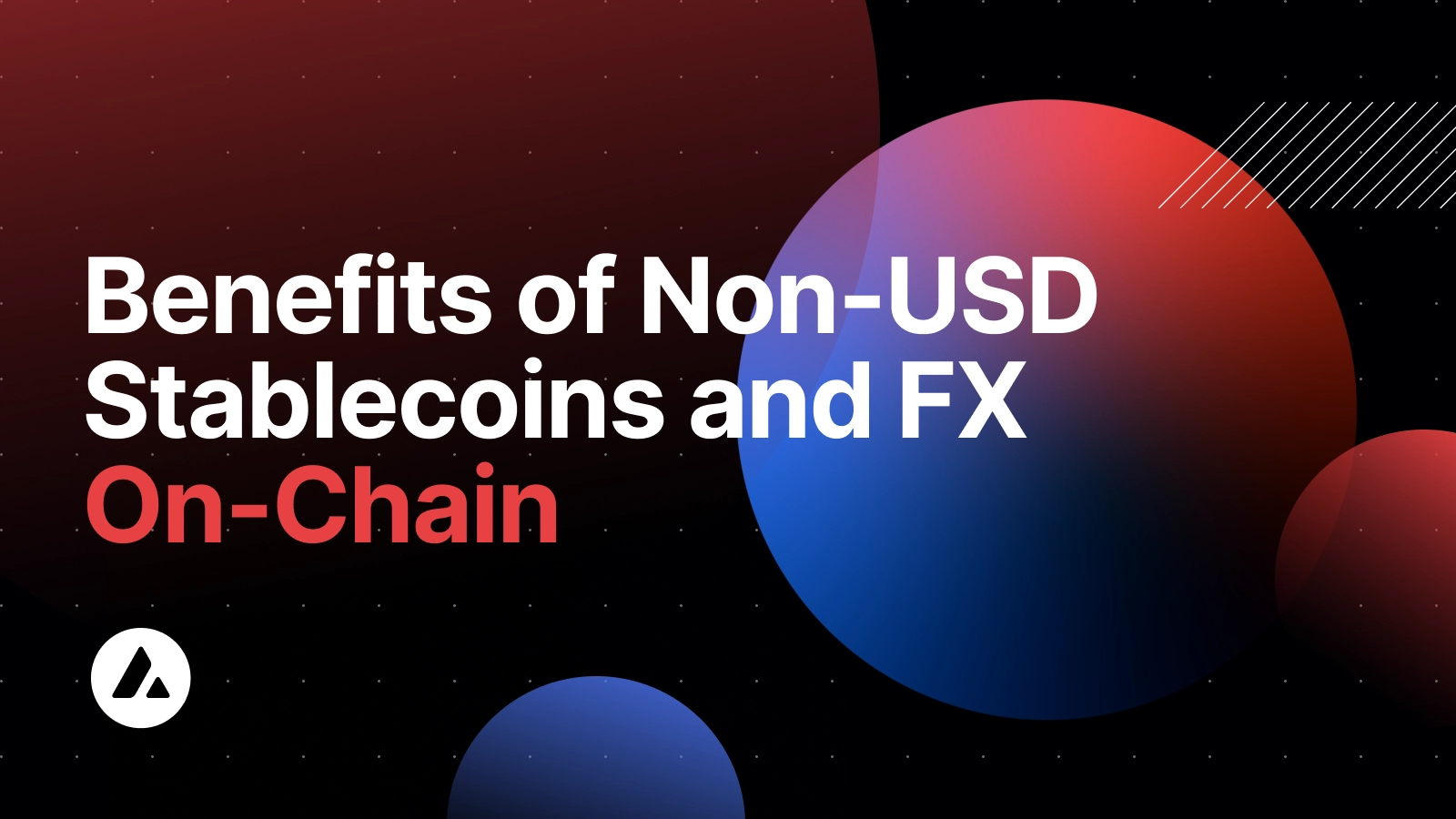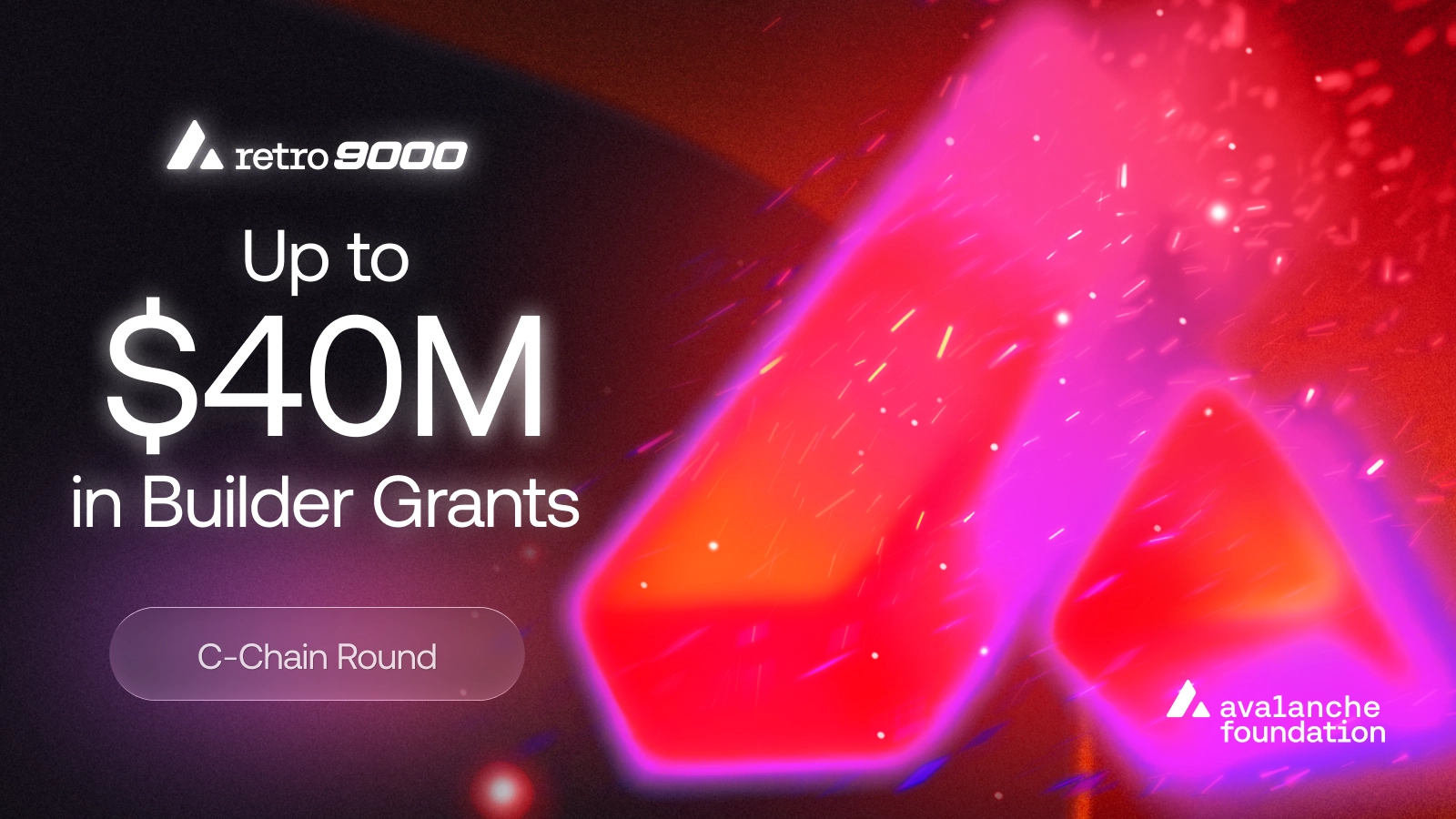The Tangible Benefits of Bringing Non-USD Stablecoins and FX On-Chain
The Tangible Benefits of Bringing Non-USD Stablecoins and FX On-Chain
Oct 16, 2023 / By Avalanche / 14 Minute Read

Addressing the opportunity for tokenization of non-USD stablecoins and the creation of FX markets currency derivatives markets
Tokenization of off-chain assets (OCAs) has been gaining momentum. The world’s Fiat currencies are an asset class ripe for tokenization, and USD stablecoins have already been among the most adopted and transacted tokenized OCAs so far. Even so, there is a much larger opportunity stemming from the tokenization of non-USD stablecoins and the creation of FX markets and currency derivatives markets on-chain. Let’s explore the many benefits and opportunities.

Inline image from: The Tangible Benefits of Bringing Non-USD Stablecoins and FX On-Chain
Source: BIS Quarterly Review, December 2022
The United States dollar (USD) remains the world’s principal reserve currency and the most widely used for international trade. The USD accounts for a 60% – albeit declining – share of foreign exchange reserves worldwide. It also accounts for around 40% of SWIFT payments and 85% of FX transaction volume.
USD-denominated stablecoins are even more dominant on-chain. As of October 2023, the total market capitalization of USD stables sits at $125B, and the market capitalization of non-USD stables at $425M, or about 0.34%. This places on-chain USD dominance at 99.66%. This dominance extends to trading volume, with over $30-40B in daily volume for USD stablecoins versus around $5-10M for non-USD stablecoins, which places USD stablecoin dominance by trading volume at over 99.97%. In short, non-USD stablecoins are virtually nonexistent today.
In crypto, USD is dominant. The blockchain industry strives to be global, accessible, and inclusive. These values, however, have not yet enabled greater accessibility through non-USD stablecoins and robust, efficient on-chain FX markets, which in turn would unlock atomic intra- and cross-border payments and remittances, macro directional trading, individual, corporate, and institutional hedging, etc.
Before trying to create new alternative currencies, the industry should focus on creating better markets and payment flows for existing currencies – that is, solving real world pain points and upgrading legacy infrastructure.
If on-chain finance achieved a similar distribution to traditional finance, non-USD stablecoin market capitalization could easily grow to around $50B, and daily trading volumes could rise to around $20B. This would lay groundwork for the accessibility and inclusivity many industry actors are working toward.
After all, this is why we Crypto.
The Role of Stablecoin Regulation
Regulations for stablecoins in the US remain opaque and contentious. Several other jurisdictions have been faster to provide regulatory clarity.
In the UK, electronic money regulations and payment service regulations have been amended to include stablecoins, and the Financial Services and Markets Act 2023 recently passed into law. Another example is the Markets in Crypto Assets (MiCa) regulation in the EU, which sets out a clear path for stablecoin issuers to become regulated. Japan has also introduced its own stablecoin regulatory framework in 2022. Singapore recently did the same. Similar efforts to regulate stablecoins are in motion around the world.
The US lag will likely catalyze the growth of non-USD stablecoins.
On-chain FX Trading
Perhaps the most obvious and foundational benefit of growing non-USD stablecoin issuance and liquidity on-chain would be the ability to create alternative foreign exchange (FX) markets with better uptime, smaller transaction fees, and atomic trade finality and settlement. Robust, on-chain FX markets can benefit a whole spectrum of use cases and end users while removing the reliance on antiquated infrastructure and various third party intermediaries (for more on this, see Circle and Uniswap’s report here).
One clear use case is the ability for FX markets to facilitate macro directional trading, as well as hedging – whether for institutional, corporate, or retail users. Existing on-chain exchange protocols could enable FX trading, including:
Automated Market Makers (AMMs)
Concentrated Liquidity Market Makers (CLMMs)
On-Chain Central Limit Order Books (CLOBs)
Automated Market Makers (AMMs)
AMMs were the first generation of exchanges that could operate fully on-chain and handle price discovery based on market dynamics. They rely on liquidity pools in which liquidity providers (LPs) deposit an equal value of two tokens to facilitate trading for a specific pair.
Price impact or slippage refers to the influence of a specific trade on the price of the tokens. It is proportionate with the size of the trade relative to the amount of liquidity available in the pool. There is a minimum price impact value typically ranging around 30bps on constant-product AMMs: this is the fee charged for each trade.
Unlike a traditional order book where liquidity is aggregated into specific amounts and at specific prices based on market maker activity, AMMs can offer blanket liquidity, where LP contributions cover all sizes and prices. This makes providing liquidity much more accessible by a variety of market participants, but it’s also a much less capital-efficient approach. Still, this allows for the creation of composable deposit tokens, or LP tokens, which represent these positions and their associated yield. LP tokens can be deployed across on-chain protocols (including as on-chain collateral).
Optimization of AMMs for Stableswaps
Some AMMs are designed to facilitate swaps between assets that are highly correlated in price. These are often called “stableswaps.”
Stableswap AMMs, such as Platypus or Curve, can be optimal for pairing stablecoins pegged to the same underlying currency. For example, they can offer the ability to swap two euro-pegged stablecoins. For stableswap end users, these AMMs can offer many functional on-chain benefits, including the ability to:
Easily convert holdings to a new or preferred stablecoin provider
Diversify exposure beyond a single provider
Quickly swap holdings for deployment into a particular DeFi opportunity
Convert holdings because of infrastructure integrations (e.g., if an on/off ramp provider accepts or prefers a particular stablecoin)
Overall, stableswaps make it easier to hold and deploy stables on-chain, while providing LPs with an attractive, relatively lower risk opportunity than standard AMMs.
Concentrated Liquidity Market Makers (CLMMs)
CLMMs are hybrid constructs that combine properties of AMMs and order books, essentially creating efficient on-chain pseudo order-books.
This model was pioneered by Uniswap with the introduction of Uniswap V3 but has since been widely adopted, with competitors like Trader Joe introducing changes. CLMMs abandon the lazy liquidity property associated with traditional AMMs in favor of better capital efficiency. As the name suggests, they concentrate liquidity in price ranges and require LPs to take a more active role when depositing and distributing liquidity. A good way to conceptualize CLMMs is to see them as order books with a very large tick size.
Oracle-Based Concentrated Liquidity Exchanges
Some exchanges abandon the ability to achieve price discovery and instead rely on oracles to concentrate liquidity around an existing, off-chain market price. They can not safely be relied on as primary sources of liquidity but can provide very competitive secondary on-chain venues for FX trading by referencing off-chain pricing. A good example of this model is Xave.
On-Chain Central Limit Order Books (CLOBs)
On-Chain CLOBs are, for the most part, self-explanatory. Their mechanism is identical to most centralized exchanges operating today with an order book that matches both buy and sell orders at a specific price. For a long time, they were impossible to host on-chain due to throughput and finality limitations of older blockchains. However, newer technologies, such as Avalanche Subnets, enable dedicated blockchains to host these transaction-intensive order books on-chain. A good example is Dexalot.
These exchanges, if adopted by enough market makers to create liquid markets, could rival the capital efficiency of existing off-chain FX markets. They are, however, less composable and much less accessible for retail users when it comes to providing liquidity.
Quantifying the Competitiveness of On-chain Exchanges
Particularly for retail end users and small businesses, those who typically are disadvantaged the most by wide FX spreads (see below for further details), on-chain exchanges should serve as a more competitive and compelling option than traditional solutions.
In the case of the EURC token on Avalanche, which trades on Xave and Trader Joe, the price can deviate from the official exchange rate by up to 1%:

Inline image from: The Tangible Benefits of Bringing Non-USD Stablecoins and FX On-Chain
Source: Flipside EURC dashboard
Deviations typically occur when given trade volume disproportionately surprasses available liquidity. For example, the EURC/USDC pool on Trader Joe currently has $1.5M of total liquidity but has seen up to $2.8M in daily volume. The same pool on Xave has $610k of liquidity but has seen $790k in daily volume. You’ll notice the deviation is quickly corrected (based on the chart above). This correction is effectuated by market arbitrageurs tracking the official off-chain exchange rate and rebalancing the AMM pool to make a profit.
You can see this rebalancing in action in the chart below, which shows how the distribution of EURC and USDC within a Xave pool changes over time, regularly going in and out of balance:

Inline image from: The Tangible Benefits of Bringing Non-USD Stablecoins and FX On-Chain
Source: Flipside EURC dashboard
Even in the most extreme deviations, however, the spread remains substantially below that which a retail user or small business might have to pay for a comparable FX transaction off-chain and quickly compresses.
Overall, on-chain innovations can upgrade legacy infrastructure and potentially eliminate the need for third-party intermediaries charging unnecessary fees for smaller transactions (see below for more details). Additionally, AMMs may create novel passive income for a wider set of participants through the LP pool model.
Summary Advantages of On-Chain FX Trading
24/7
Less expensive especially for retail and small businesses
More widely accessible
Composable
Instant transactions finality and settlement
Less operationally intensive
Remittances and Cross-Border Payments
Creating alternative, liquid FX markets on-chain is the first step toward a much larger vision from a global utility and payments perspective. Remittances and cross-border payments have long been complex and expensive, in part due to limitations of legacy banking infrastructure and extractive intermediaries.
In 2022, countries received more than $831b of combined remittance inflows, with over 77% of these inflows received by low- and middle-income countries. India, Mexico, China, the Philippines, and France were the top five countries with the most remittance inflows.
Western Union fees can be as high as 29% for smaller payments, and brokers are allowed to collect a margin of up to 6% on FX transactions for most countries (excluding the Eurozone). In comparison, swapping on FX exchanges on-chain would incur fees of around 0.01% to 0.3%, in addition to fixed transaction fees that would be a few cents per transaction. Even including on-ramping and off-ramping fees, which range between 1.5% and 4% in most cases, as well as price deviations, remittances on-chain remain competitive.
A prime example: Lebanon, the world’s most remittance-dependent country, with remittances accounting for over 50% of the country’s GDP. Sending money in and out of the country is a real struggle. The lucky few rely on foreign bank accounts, but most people must use (dysfunctional) Lebanese banks or intermediaries, where they pay predatory, inaccurate exchange rates and eye-watering fees.
There is a real opportunity here: the current on-chain infrastructure is already much more efficient, cheaper, and more transparent than traditional remittance payment rails in most developing economies.
Derivatives
In addition to spot transactions, robust on-chain FX markets would also promote the creation of derivatives markets for macro directional trading and hedging purposes.
Protocols such as Hubble and GMX can be used to create perpetual futures that track the price of underlying currencies and enable leveraged trading strategies. Protocol profits from trading and market making can be redistributed to liquidity providers, creating additional opportunities to earn yield on on-chain currency deposits (as mentioned earlier).
On-chain options protocols can become powerful tools for hedging exposure to currencies. There are many different protocols that have the potential to enable this, ranging from fully on-chain models (Panoptic, Kibo) to hybrids relying on off-chain market makers and order books (Volare, Aevo).
A large reason why on-chain options protocols (and, to an extent, perpetual futures exchanges) are still limited in liquidity is their focus on crypto assets. Introducing derivatives for various well-adopted, non-USD stablecoins could be instrumental in driving the growth of these protocols by attracting exponentially higher liquidity.
In the shorter term, synthetic currency derivatives can let users trade and get price exposure to smaller local currencies. A good example: Baki, a protocol aiming to create synthetic FX markets for African currencies.
There is still work to be done across these areas, but on-chain protocols have the potential to replace traditional currency derivatives markets.
Creating Liquid Markets for Historically Illiquid Currencies
This last use case could be one of the most immediate opportunities for non-USD stablecoins. Think of Argentina, Lebanon, Syria or Ethiopia. They have one thing in common: reliance on black markets for trading and pricing local currencies. In some cases, this is exacerbated by capital controls imposed on banks and restrictions on currency outflows.
This generally means that these local currencies are trading with very fragmented liquidity and without a unified price. Each broker will quote slightly different prices, with limited liquidity; there is no common trading venue. This means that spreads are generally extremely wide to account for uncertainty and high volatility. It also means that currency prices are easily manipulated.
Locals generally rely on websites and apps attempting to track the parallel black market rates, relying on brokers and users declaring their recent trades:

Inline image from: The Tangible Benefits of Bringing Non-USD Stablecoins and FX On-Chain

Inline image from: The Tangible Benefits of Bringing Non-USD Stablecoins and FX On-Chain
This might be solved by tokenizing the local currency and listing it on an on-chain exchange. On-chain exchanges could provide more accurate, transparent alternative rates for these currencies, while also reducing liquidity fragmentation. Of course, this would require existing participants in these markets to adopt a given on-chain exchange as a primary source of truth. Each individual broker could act as an on-ramp and off-ramp for the stablecoin, where locals could deposit or withdraw their local currency.
Such an initiative would require collaboration and oversight, but would allow locals to trade their local currency remotely, at better rates, and reduce their reliance on cash. They could receive USD-denominated stablecoins in return, which they can then either off-ramp through existing peer-to-peer networks or hold on-chain and transfer at extremely competitive fees.
Key Takeaways
The crypto industry often assumes that there is no demand for non-USD stablecoins. But this is not true in traditional finance: demand exists.
The state of international stablecoin regulation makes this opportunity even clearer.
On-chain exchanges are already developed enough to provide competitive venues for FX trading, with instant settlement, lower fees, better pricing, and 24/7 markets.
Improving the availability and liquidity of non-USD stablecoins on-chain is the first step in addressing real-world problems of remittances and cross-border payments. These markets are currently larger than the entire crypto space several times over.
Institutional adoption can follow retail adoption: there are exchanges that perfectly mimic traditional exchanges, and various protocols that can provide markets for on-chain currency derivatives, which can be used for speculation or hedging.
The opportunity is the clearest in emerging economies, which often lack necessary banking infrastructure and are subject to inefficient and predatory FX markets for cross-border payments, remittances, and trading of their local currencies.
Provided for informational purposes only, without representation, warranty or guarantee of any kind. None of this is as an endorsement by Ava Labs, Inc., the Avalanche Foundation Limited or any of their respective subsidiaries or affiliates, nor is any of this investment or financial advice. Please review thisNotice and conduct your own research to properly evaluate the risks and benefits of any project
About Avalanche
Avalanche is a high-performance blockchain platform designed for builders who need to scale. Engineered with a revolutionary three-part Layer 1 (L1) architecture, Avalanche is anchored by its Avalanche Consensus Mechanism, ensuring near-instant finality for transactions. The platform also features an open-source Layer 0 (L0) framework, enabling the seamless creation of interoperable Layer 1 blockchains with high throughput on both public and private networks.
Supported by a global community of developers and validators, Avalanche offers a fast, low-cost environment for building the next generation of decentralized applications (dApps). With its unique blend of speed, flexibility, and scalability, Avalanche is the preferred choice for innovators pushing the boundaries of blockchain technology.
Website | Whitepapers | Twitter | Discord | GitHub | Documentation | Telegram | Facebook | LinkedIn | Reddit | YouTube



